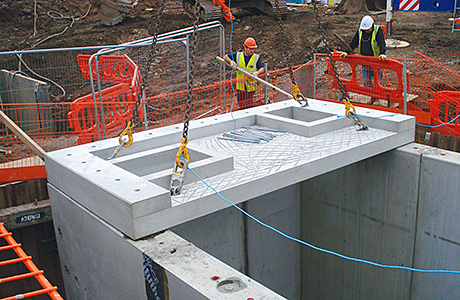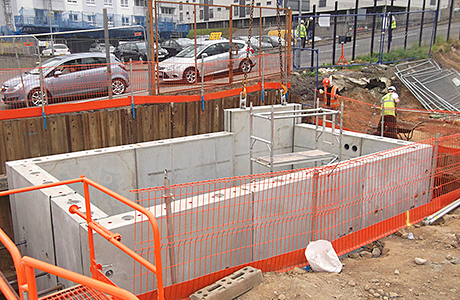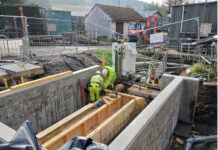
FLOODING is big news right now – and not just in the soggy Somerset Levels.
Appalling weather, along with an ageing water and waste water infrastructure have combined to create serious flood risks all over the UK.
Several parts of the country have been suffering periodic flooding for years as waste water infrastructure struggles to keep up with the increased loads imposed by urban development.
Glasgow is no exception and Scottish Water is in the early stages of a £250 million five-year programme to upgrade its waste water network in the Greater Glasgow area. This scheme is the biggest investment in Glasgow’s waste water network since Victorian times and is designed to alleviate sewer flooding and deal with the effects of increased rainfall and climate change.
It will also improve river water quality and the natural environment in the River Clyde and its tributaries. As part of what is being called the “Glasgow Environmental Programme”, contractor George Leslie Ltd is undertaking major sewer network improvements, which include installing a series of combined sewer overflow (CSO) chambers at strategic points on the sewer network.
In combined sewers, which carry both domestic waste and surface water run-off, CSO cham bers act as emergency discharge valves to prevent flooding during periods of heavy rainfall.
The CSO reduces the hydraulic loading on the treatment plant by diverting dilute excess flows to appropriate alternative waterbodies.
These structures, some of which measure up to 12m in length and over 5m wide, are traditionally constructed in-situ, with concrete poured into a formwork erected in the excavation and containing reinforcing steel.
The in-situ approach uses familiar techniques but it is a lengthy and labour-intensive solution.
CSO chambers are always located underground and to construct one in-situ, the contractor has to work inside the excavation to assemble the steelwork and shuttering. This has obvious health and safety implications.
Once the formwork is in place, the concrete must be delivered to site and poured. Then it has to cure until it has reached sufficient strength for the shuttering to be struck and removed. Only then can the pipe connections be completed, the top slab installed and the excavation back-filled.
The alternative is to install pre-cast concrete CSO chambers. Small ones can be supplied in one piece, with just the internal fixtures and seals requiring to be fitted on site. Larger CSO chambers can be assembled from pre-cast components either on a concrete base slab cast in-situ or on a slab which is also made from pre-cast panels.
Kiljstra is one of two pre-cast concrete suppliers regularly employed by George Leslie Ltd on the Glasgow Environmental Programme and has supplied ten CSO chambers, three headwalls and seven kiosk bases in various sizes.
Precast components can be delivered to site and lifted into place in a few hours, allowing on-site activity to be completed very quickly and the excavation back-filled in typically 3–4 days.
Mike Gilmour, a project manager at Scottish Water, said pre-cast has a number of advantages over in-situ construction. “In terms of the main benefits of pre-cast over in-situ, the first is quality.
“The product is manufactured under factory conditions so the products are consistently of the same quality. Bad weather and unfavourable site conditions don’t affect it. Secondly there are delivery benefits in terms of time and cost.
“Quicker projects are possible, using less space as we are not constructing it all using formwork and re-bar on site.
“This is useful when we are working in close proximity to the public, greatly reducing the impact on our neighbours and customers. There are also health and safety benefits due to the reduced number of construction operations carried out on site.”
These benefits have all come to the fore on the ten CSO jobs that George Leslie Ltd has already completed using Kijlstra CSO chambers, said Steve Gainsley, project manager with Kijlstra. “At Morriston Street we supplied a panel system for a CSO located in school grounds next to a busy road. The programme timescales were tight as the CSO had to be constructed during the summer holidays and the pre-cast solution allowed the programme dates to be achieved.”

At another site, Johnson Drive, the site was in the car park of an active medical centre. “Full possession of the car park to carry out works was a matter of hours,” added Mr Gainsley. “Using our two-piece Vario chamber allowed installation within three hours, and at night minimising disruption.”
Due to it’s speed of construction a two-piece Vario unit also proved the ideal solution at Thornliebank Road, in the Glasgow suburbs, where traffic management was a major disruptive factor as the works were located on an arterial traffic route into the city centre.
“Reduced time on site is undoubtedly one of the biggest advantages of precast,” said Andrew MacLeod, Construction Manager with George Leslie Ltd.
However, he pointed out that in some instances in-situ construction is still appropriate. “Depending on the location it might be more economical to use in-situ concrete.”










